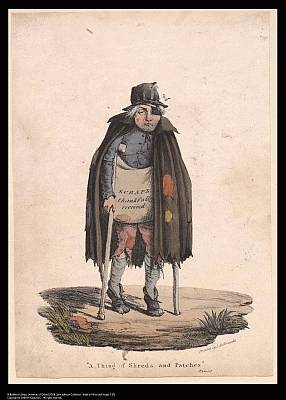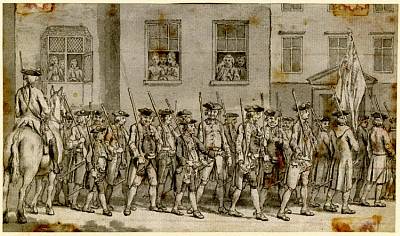Searching for images: a research guide
Connected Histories gives you direct access to three collections of images. The most substantial of these is the British Museum Image Collection, which includes 96,566 images relating to British subjects 1500-1900. In addition The John Johnson Collection of Printed Ephemera from the Bodleian Library, provides access to 67,754 documents which include among them, over 39,000 illustrations. And the Database of Mid-Victorian Illustration includes records and images of 868 literary illustrations published in or around 1862.
Contents of this article- The scope and breadth of the collections
- Strengths and weaknesses
- Search strategies
- Further reading
- Related websites
The scope and breadth of the collections
Representing over 250 years of active collecting and curation, the British Museum collection of prints and drawings (a subset of which is searchable through Connected Histories) is simply one of the strongest and most comprehensive collections of images on paper in the world. It has huge strengths in topographical prints, portraits and satires covering the whole period from 1500-1900; and includes examples of the work of Hogarth, Turner and Blake. It also incorporates the Crace Collection of maps and views of London. For a detailed history and description of the collection see the British Museum website.
The John Johnson Collection is more directed to specific topics and areas, with particular strengths in materials relating to nineteenth-century entertainment (such as play bills); the booktrade (including bookplates); popular prints; materials relating to crime, murders and executions; and advertising. It forms one of the largest collections of ephemeral material available.
The Database of Mid-Victorian Illustration (DMVI) provides high quality scans of 868 literary illustrations published in or around 1862, in association with detailed bibliographical and iconographical data.
Strengths and weaknesses
By combining access to the British Museum, John Johnson and Mid-Victorian Illustration collections, Connected Histories provides access to a uniquely rich collection of ephemera (an area of huge strength in both collections). Theatre and advertising materials are also present in large amounts in both collections; while the British Museum's collection is unsurpassed in terms of topographical images of British sites.
Although there are many portraits among the materials searchable here, other collections, such as the National Portrait Gallery, are more comprehensive; while thematic collections such as Wellcome Images provide a greater variety of images organised around subjects such as the history of medicine.
Search strategies
In searching for images, it is important to remember that you are searching on the catalogue entry for an image, rather than the image itself. As a result, your ability to locate relevant images is dependent on the words and categories of information used by the original cataloguers to describe each image. In the case of the British Museum Image Collection, a typical catalogue entry includes information about: the object type, dimension, materials and techniques employed; the creator and the date of production; and the accession of the image into the collection and its provenance.
In addition, each entry will include a brief (50-250 word) description of the content of the image. A typical example might be the description associated with Samuel Wale's untitled pen and ink drawing of a group of soldiers:
- Design for a book illustration, possibly a scene from the Gordon Riots; regiment of volunteers marching with muskets along street towards right, preceded by Union Jack, soldier on horseback left, people watching from windows. Pen and grey and brown ink and grey wash.
In contrast, while images in The John Johnson Collection of Printed Ephemera contain most of the details of production type and provenance, they do not include detailed prose descriptions, and instead the subject matter of the images is recorded as a series of keywords drawn from a limited vocabulary. The Database of Mid-Victorian Illustration (DMVI) is different again and incorporates its catalogue data within a strict taxonomy - so Essex is a subset of England, etc. This makes identifying specific subjects in the DMVI much easier.

A typical image from the John Johnson collection, a genre print from 1828 entitled A thing of shreds and patches, which depicts a beggar in rags, is associated with all the following keywords:
- Beggars; eye patches; tobacco pipes; pleading (Begging); beggar; begging; worn or torn clothes; head-gear: eye-patch; crutches; blind, blindness; coat, cape; carrying something in basket, bag, rucksack; and pipe - tobacco
In all three collections, locations and individuals, where they can be identified, are included in the cataloguing data.
Unless you are interested in the works of a particular artist or medium, the most effective search results derive from general keywords of the sort used by The John Johnson Collection of Printed Ephemera, and which appear in the longer descriptions provided by the British Museum Image Collection. You can limit these by date, or attempt to search for names of individuals and events, but the limited amount of text associated with any one image ensures that these strategies will miss important items. It is better to find a simple word, beggar, riot, or fight, than a more precise one, mendicant or altercation. The wide variety of ways of recording most British place names means that it is frequently better to use a subset of a name (such as Giles for St Giles in the Fields), or to incorporate alternate spellings in your search.
If you are interested in searching for images by a particular artist, or which have distinct characteristics associated with the medium or provenance, it is probably better to search the following collections using their own specialised search facilities.
Further reading
- M. Duffy, The English Satirical Print 1600-1832 (6 vols., Cambridge, 1986)
- S. O'Connell, The Popular Print in England (London, 1999)
